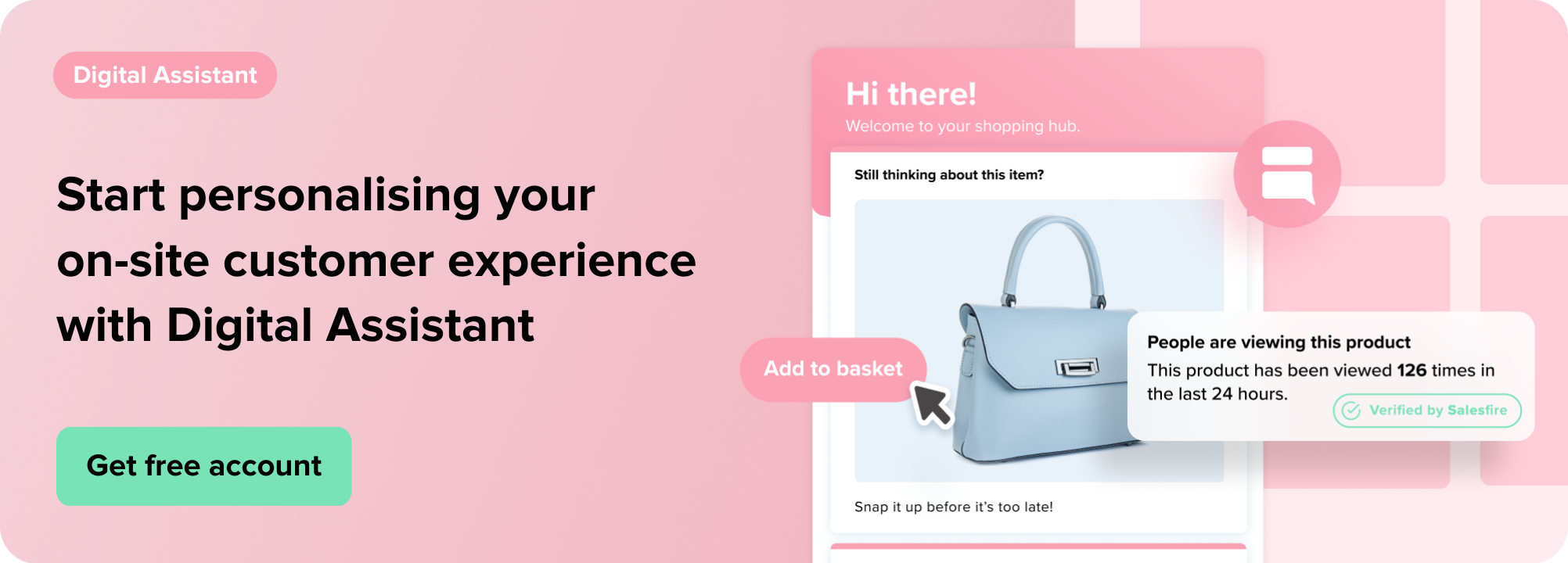How to Boost eCommerce Sales For the Long Run
By Sophie Walker • Last updated: Monday Apr 29th, 2024

The post-pandemic landscape has not been an easy space for online retailers to navigate.
A number of factors have merged to impact not only customer behaviour but also supply and fulfilment processes.
To succeed in the current economic climate, businesses need to take a long-term perspective on boosting eCommerce sales and taking care of loyal customers.
The state of eCommerce
It’s been a turbulent year for eCommerce. The cost of living crisis, disruption to supply chains, and looming economic challenges have meant that many of us are shopping more cautiously.
Reports show that 58% of UK adults have reduced their spending on non-essential items in the last six months.1 Coupled with rising acquisition costs, the challenge for retailers to secure sales and improve conversion rates has been felt across most industries.2
Global events like the war in Ukraine have also had a knock-on effect on supply chains, causing costs to rise further and significantly impacting retailers.
What does this mean for online retailers?
During these challenging times, retailers should adapt their strategies to meet the needs of their shoppers.
The best sales strategies in 2023 will focus on reinforcing brand loyalty, offering a seamless online shopping experience, and optimising the on-site journey.
eCommerce retailers should look at ways they can increase their sales in the long term, and build a base of loyal customers who will choose to invest in their brand time and time again.
Now that we’ve outlined the current state of eCommerce, let’s delve into some of the ways you can boost eCommerce sales in the long run.
Suggested reading: Read our report, ‘The State of eCommerce in 2022’, to learn more about today’s online sales climate.
Use personalisation to boost eCommerce sales
Customers want to see genuinely relevant content when shopping – and a growing body of evidence shows that this level of personalisation is not only desirable, but expected.3
Personalisation tools tailor the content and campaigns displayed to shoppers based on their on-site behaviour and what stage they’re at in the buyer’s journey.
All-in-one personalisation solutions such as Digital Assistant are growing in popularity, as retailers work to meet the needs of modern shoppers.
Digital Assistant is equipped with campaigns that display at exactly the right time to influence shopper behaviour and increase your conversion rate.
Some of the personalisation campaigns that you can create through Digital Assistant are:
- Recently viewed products: Personalise the browser journey by displaying your shopper’s recently viewed items and allow them to effortlessly return back to the products they loved.
- Bespoke messaging: Remind your shopper of your limited-time promotions or free shipping incentives by displaying an Overlay at exactly the right moment.
- Promotions: Promote key sections of your website, showcase your latest blog post, or prioritise building an email list with a newsletter sign-up campaign.
Shoppers have come to expect levels of personalisation when they visit an online site. Integrate intelligent eCommerce personalisation solutions on-site to ensure customer journeys are both tailored and seamless.
Pro tip: It’s essential to implement personalisation throughout all your channels, not just on-site. Nurture your shoppers with personalised email marketing campaigns by including:
- Personalised subject lines: Capture a user’s attention by including their name in your email content.
- Basket abandonment emails: Encourage users to return back to the basket they have built with a basket abandonment email sequence.
- Nurture emails: Include incentives and discount codes most relevant to the user, along with your latest news and releases. This will help to keep customers engaged with your brand.
Optimise the product discovery process
When a customer lands on a site, they might not know what they want to buy, or might not even have the intention to make a purchase.
Optimising the product discovery process increases the likelihood of a sale by connecting your shopper with their perfect purchase.
One way to streamline the product discovery process is by offering product recommendations that utilise the data you’ve collected on-site.
After all, 49% of consumers say that after receiving a personalised recommendation they have purchased a product that they did not initially intend to buy.4
Salesfire’s AI-driven Recommendations displays genuinely relevant product matches based on shopper’s data.
Recommendations match up similar customer journeys and utilise user behaviour insights to deliver them the products they will love.
Recommendations can be used throughout the buyer funnel to:
- Engage new visitors: Showcase bestsellers and ‘new in’ items on landing pages and your homepage to inspire new visitors to browse your product catalogue.
- Connect shoppers to their perfect purchase: Displaying similar items on product pages can help a user find the product that’s right for them.
- Inspire additional purchases: Encourage shoppers to grow their baskets with bought-together strategies on checkout pages.
Point to consider: You can display personalised Recommendations at the right time in the checkout process to effectively upsell and cross-sell products, inspiring those last-minute basket additions and boosting your AOV.
Suggested reading: Read our article, ‘6 Ways to Use Product Recommendations’, to discover more Recommendations-driven sales strategies.
Prioritise customer service
81% of consumers conduct online research before making a purchase online.5
As shoppers become more cautious with their spending, many will conduct research before they commit to a purchase. This might include going on price comparison sites, or visiting a site multiple times before finalising an order.
This means it’s crucial that your support channels are armed to provide customer service when needed, and answer queries in good time.
Consider integrating an on-site live chat to ensure your shoppers are getting the answers they need. This level of support helps shoppers to progress along the buyer’s funnel, and empowers them to complete their purchase.
And as it becomes harder to secure those all-important conversions, providing the information customers are looking for has never been more important.
It’s a fact that people trust the experiences of other shoppers when shopping, with 93% of consumers saying that online reviews influenced their purchase decisions.6
You can use eCommerce social proof to ensure that your shoppers know that your brand is highly trusted, and offers excellent service.
Digital Assistant allows you to showcase customer reviews on your product pages and boost your shopper’s confidence in completing their purchase.
Providing a high level of customer service and the information customers are looking for helps shoppers feel valued, instils trust, and increases customer loyalty.
Suggested reading: To learn more about the importance of the eCommerce customer experience, check out our blog, ‘What Is eCommerce Customer Experience and Why Is It Important’.
Retarget shoppers
As eCommerce competition grows and it becomes harder to generate repeat shoppers, it’s essential for retailers to create robust customer retention strategies that effectively retarget existing customers and inject them back into the buyer’s funnel.
Retargeting focuses on reaching the customers who have already interacted with your eCommerce website and brings your brand back to the front of their minds.
Some of the ways you can effectively retarget your shoppers through your marketing materials are:
- Social media advertising: Social media can be used to retarget shoppers and offer retailers the opportunity to become more granular with the audiences they want to reach. This could mean using Instagram, LinkedIn, or Facebook ads.
- Dynamic landing pages: Create dynamic landing pages that show the most relevant content to your shoppers and improve the results of your PPC campaigns. These should be optimised to work seamlessly on desktops and mobile devices.
- Email marketing: Combat cart abandonment and nurture your existing shoppers with retargeting email marketing strategies.
With competition in eCommerce on the rise, retailers can leverage PPC and advertising to retarget shoppers and direct them back to their sites, preventing them from purchasing from a competitor.
Ahmed Chopdat, Commercial Director of Circus PPC Agency, says:
“Despite the effects that the post-pandemic recession, cost of living crisis, and war in Ukraine, have had on eCommerce sales, it’s important to remember that different markets have been impacted in different ways, and there’s no ‘one-size-fits-all’ way of ensuring an increase in sales.
“However, AI in PPC has seen more development over the past few years than ever before and can help brands and companies to drive success and improve performance across their PPC accounts with obviously a human touch. One of the biggest ways in which AI can be utilised for success is to create detailed reports that provide all of the data that you need at your fingertips.”7
The wealth of data that retargeting campaigns generate can then be used by retailers to gain valuable insights into their shopper’s behaviours and identify opportunities to strengthen marketing strategies.
Pro tip: Using Salesfire tools, you can target your on-site campaigns towards different traffic sources. If a shopper arrives on your site from a specific domain or landing page, you can tailor your on-site messaging to match the content they’ve previously viewed. This allows you to further personalise the campaigns that you display and target the shoppers you want to reach.
Next steps: boost your eCommerce sales in 2023
In the current economic climate, securing sales is becoming more and more challenging. Retailers need to look at ways they can get ahead of the curve, anticipate the ever-changing needs of their customers, and gain a competitive advantage in their eCommerce space.
Optimising the on-site customer journey and offering excellent customer service can enhance the user experience, increase loyalty and boost sales in the long term.

1 How will the cost-of-living crisis affect eCommerce | Asendia
3 Personalized experience for customers: Driving differentiation in retail | McKinsey
4 Personalization Trends and Statistics to Follow in 2023
5 19 Powerful eCommerce statistics that will guide your strategy in 2023 | Oberlo
6 The Impact of Online Reviews on Consumers’ Purchasing Decisions: Evidence From an Eye-Tracking Study
See how Salesfire can help you optimise your product discovery experience, email one of our experts at [email protected] or book a free demo of our personalisation tools.




